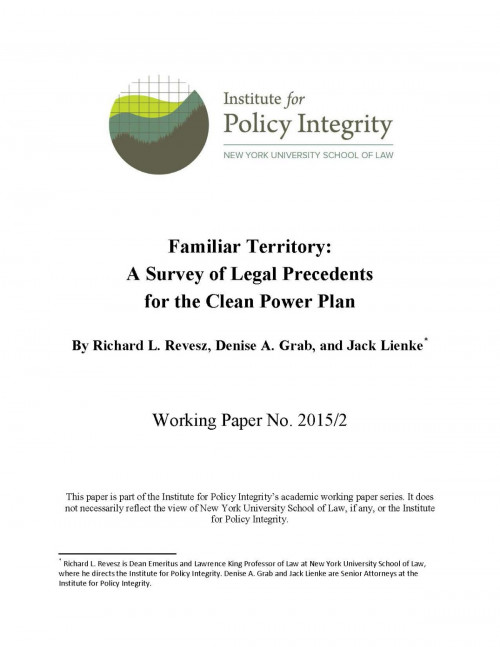-
Livermore/Revesz Article Honored
A recent article by Policy Integrity’s director, Richard Revesz, and founding executive director, Michael Livermore, has been selected for inclusion in the ninth annual Environmental Law and Policy Annual Review.
-

Familiar Territory
A Survey of Legal Precedents for the Clean Power Plan
In this essay, we highlight a wide variety of regulations from the Clean Air Act’s forty-five-year history that provide substantial precedent for the flexible design of the Clean Power Plan.
-
Revesz Testifies at House Hearing on Clean Power Plan
Richard Revesz testified at today’s House Energy & Commerce Committee hearing, “EPA’s CO2 Regulations for New and Existing Power Plants: Legal Perspectives.”
-
Comments on Aircraft Greenhouse Gas Emission Standards
We recently submitted comments to the EPA regarding their endangerment finding and advance notice of proposed rulemaking on greenhouse gas emissions from aircraft.
-
Helping NYC Reach a Clean Air Milestone
New York City reached an environmental milestone today as the final deadline passed in a multi-year effort to eliminate the city’s dirtiest residential heating oils. Policy Integrity played a major role in shaping and supporting the NYC Clean Heat program, which has saved hundreds of lives by curbing air pollution.
-
Supreme Court Sends EPA’s Mercury Rule Back to Circuit Court for Additional Review
Today, the Supreme Court ruled that the Environmental Protection Agency (EPA) did not consider costs at the appropriate stage of the regulatory process before crafting the Mercury and Air Toxics Standards. This rule, which regulates toxic emissions from power plants, will now be sent back to the U.S. Court of Appeals for the D.C. Circuit, where the judges will decide how the EPA should proceed.
-
Regulatory Report on Oil Dispersants
Our new regulatory report offers guidance on how how the EPA can improve its cost-benefit analysis for a new proposed rule regulating the dispersants used to clean up oil spills and other major pollution events.
-
Supreme Court Brief for Mercury and Air Toxics Standards Case
The Supreme Court will soon hear a challenge to the EPA’s Mercury and Air Toxics Standards (commonly known as the MATS rule). Policy Integrity has submitted an amicus brief in support of the EPA for this case.
-
Policy Integrity Welcomes Supreme Court Decision on Cross-State Air Pollution Rule
Policy Integrity welcomes the U.S. Supreme Court’s 6-2 landmark decision to uphold the Cross-State Air Pollution Rule, which requires upwind states to reduce emissions that cause downwind states to exceed air quality standards set by the Environmental Protection Agency (EPA).
-
Policy Integrity Supports Upholding of EPA Mercury and Toxic Standards
Policy Integrity welcomes the decision by the U.S. Court of Appeals for the D.C. Circuit to uphold the Environmental Protection Agency’s (EPA) rule limiting mercury and other toxic air pollutants emitted by fossil-fuel burning power plants, which are the largest source of mercury emissions. The decision supports EPA efforts to improve our air quality and safeguard public health.
Viewing recent projects in Environmental Health
